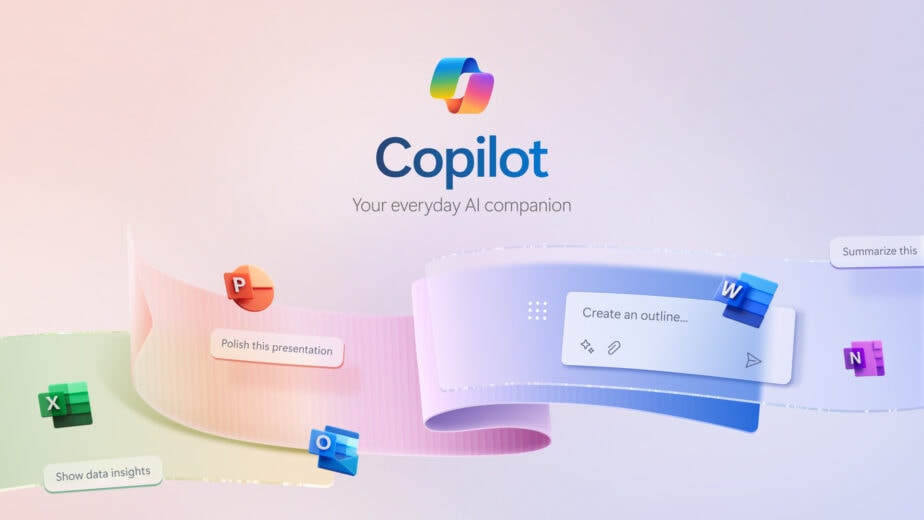Microsoft 365 Copilot is revolutionizing the way we interact with Microsoft applications by introducing cutting-edge AI-driven assistance across multiple platforms. Copilot has emerged as an essential tool within the Microsoft ecosystem and seamlessly integrates with applications such as Teams, Outlook, and Word, providing users with features that simplify their daily tasks and enhance productivity.
The importance of using Microsoft Copilot cannot be overstated. By leveraging advanced AI, Copilot not only simplifies routine tasks but also provides insightful suggestions and automates complex processes. This results in a more streamlined and productive user experience across platforms. Copilot’s ability to assist in note-taking, drafting emails, managing projects, and more underscores its value as an indispensable tool for both individuals and organizations.
Therefore, let’s talk a bit about the reasons why and how you should start using Microsoft Copilot across various applications.
Table of Contents:
- 1. Understanding Microsoft Copilot
- 2. Getting Started with Microsoft Copilot
- 3. Enabling Microsoft Copilot in Microsoft Teams
- 4. Using Microsoft Copilot in Outlook
- 5. Leveraging Microsoft Copilot in Word
- 6. Additional Applications of Microsoft Copilot
- 7. Integrating Third-Party Applications with Copilot
- 8. Advanced Tips & Tricks
- 9. Real-World Case Studies
- 10. Resources for Microsoft Copilot
- 11. How to Pilot Microsoft Copilot
- 12. Conclusion
1. Understanding Microsoft Copilot
As previously explained, Microsoft Copilot is an AI-powered tool that enhances your productivity in Microsoft 365 apps like Word, Excel, PowerPoint, Outlook, and Teams. By integrating advanced AI models and data from Microsoft Graph, Copilot provides real-time assistance to help you work smarter and faster.
The following table explain some of the key features of Microsoft Copilot:
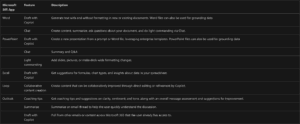
Source: Microsoft Copilot for Microsoft 365 overview
As formerly said, Copilot seamlessly fits into your favorite Microsoft apps, enhancing their functionality. For example, in Words, it helps you draft, format, and generate content based on your prompts. In Excel, Copilot offers suggestions for formulas, charts, and data insights to simplify data analysis. Additionally, in Whiteboard, it facilitates brainstorming by generating ideas and organizing content.
Find a more detailed table of features per apps in this Microsoft Article
Microsoft regularly updates Copilot with new features and enhancements. You can stay informed with the “What’s New in Copilot for Microsoft 365” monthly updates. Check this link
2. Getting Started with Microsoft Copilot
Before diving into Microsoft Copilot, make sure your setup is ready by:
- Ensuring you have a Microsoft 365 subscription that includes Copilot. Check with your IT admin if you’re not sure.
- Updating your apps if needed. Copilot works with the latest versions of Word, Excel, PowerPoint, Outlook, Teams, Loop, OneNote, Forms, and Whiteboard.
- Making sure you have permission as you need proper ones to use Copilot features, usually edit access in the apps.
Getting started with Copilot is simple:
- Check with your IT department to ensure Copilot is enabled for your organization and you have the necessary permissions and make sure all your Microsoft 365 apps are up-to-date.
- Go to the Help menu in each app and select “Check for Updates.”
- Enable Copilot: For Admins, enable Copilot in the Microsoft 365 admin center by setting permissions and configuring any necessary policies. For Users, once enabled by the admin, Copilot features will appear directly in your apps without needing a separate installation.
- Sign In: Ensure you are signed into your Microsoft 365 account. If Copilot is enabled for you, you’ll notice new Copilot options in the apps.
Once you have done that, you will be able to enable Copilot within your apps. First, make sure your IT admin has enabled Copilot for your organization. For Teams, you will then need to log in to the Microsoft 365 Admin Center, go to Teams settings, and enable Copilot. It is important that for every app, you set permissions to allow users to access Copilot features. Next, make sure you update your app to the latest version. Finally, sign in in your app with your Microsoft 365 account to start using Copilot.
Navigating Microsoft Copilot is quite simple once you know where to start. For example, in PowerPoint, just access the sidebar to create slides and get design tips. In Outlook, you’ll find Copilot right in the email composition window to help with drafting and summaries. Finally, in Teams, use Copilot to get meeting summaries and chat insights.
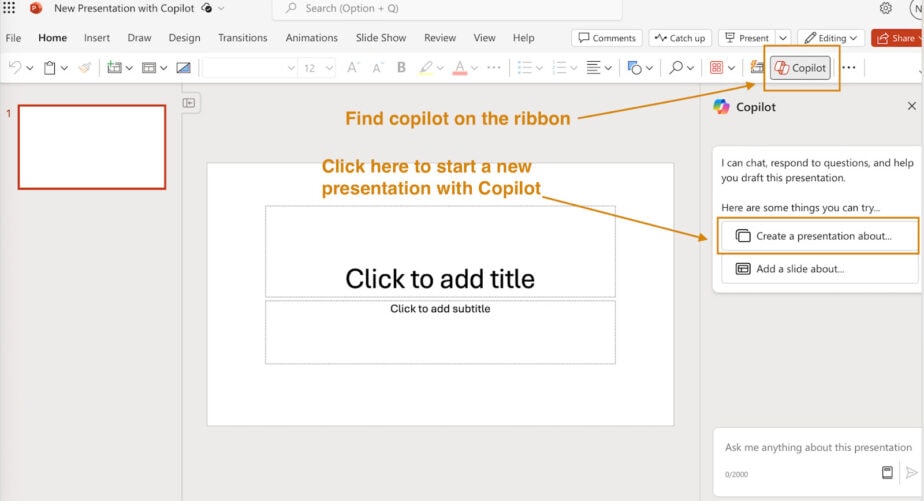
3. Enabling Microsoft Copilot in Microsoft Teams
Transforming Meetings and Task Management
Adding Copilot to your Teams app may completely revolutionize the way you handle tasks, conversations, and meetings. You may activate functions like task creation straight from your meetings and chats, discussion summaries, and automated note-taking. This integration will guarantee that no important element is overlooked while also greatly increasing efficiency.
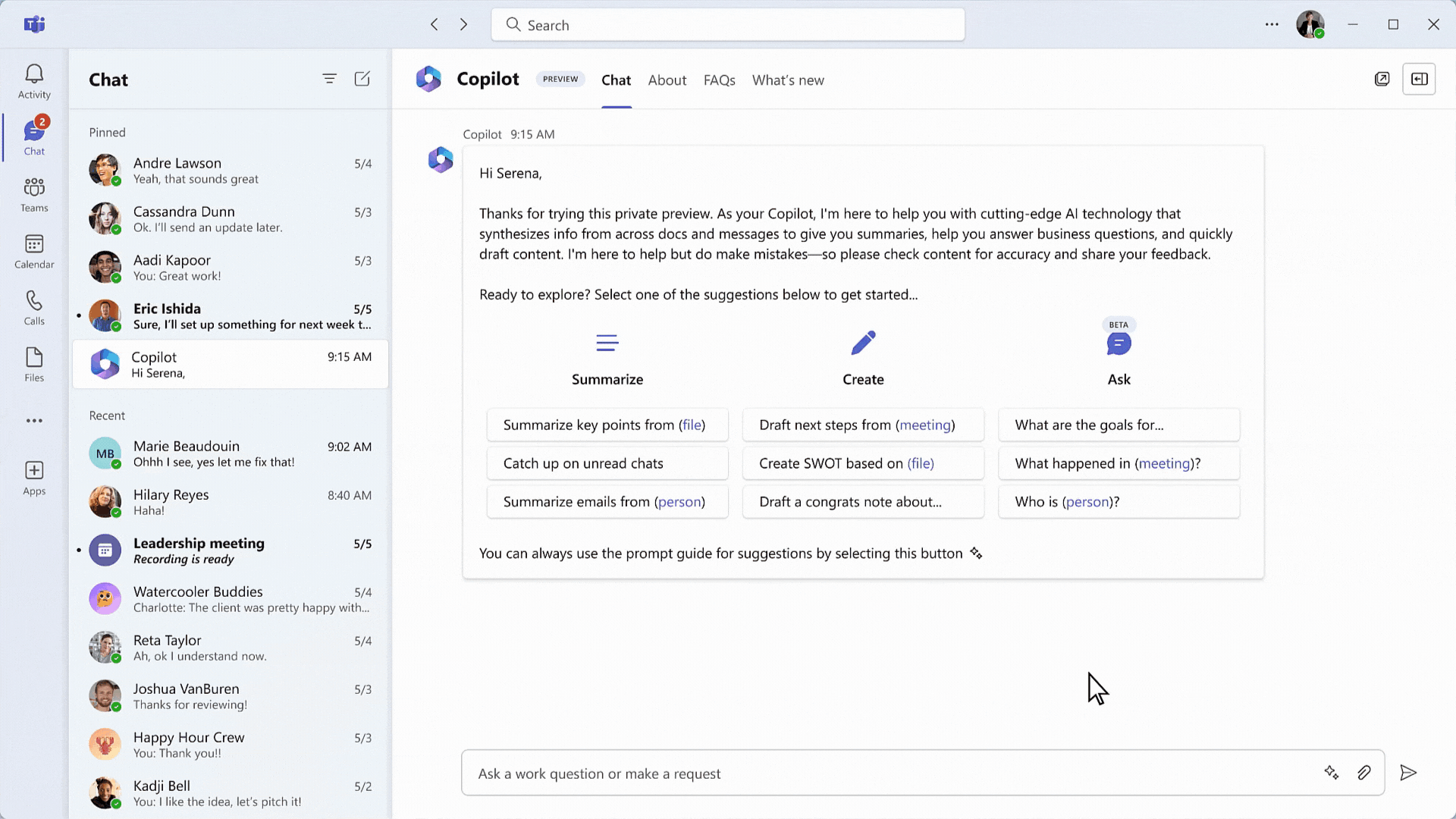
Taking automated notes during meetings is one of Copilot in Teams’ most notable capabilities. This includes capturing key discussion points, action items, and decisions made, which can then be reviewed and shared with team members. To maximize this feature, it’s helpful to set clear meeting agendas beforehand, which allows Copilot to capture the most relevant information. This helpful “secretary” enable to focus on the meeting itself rather than wasting time taking notes ourselves.
In addition to note-taking, Copilot can generate detailed summaries of discussions, making it easier to catch up on missed meetings or revisit critical points. These summaries are particularly useful for team members who may not have been able to attend the meeting live.
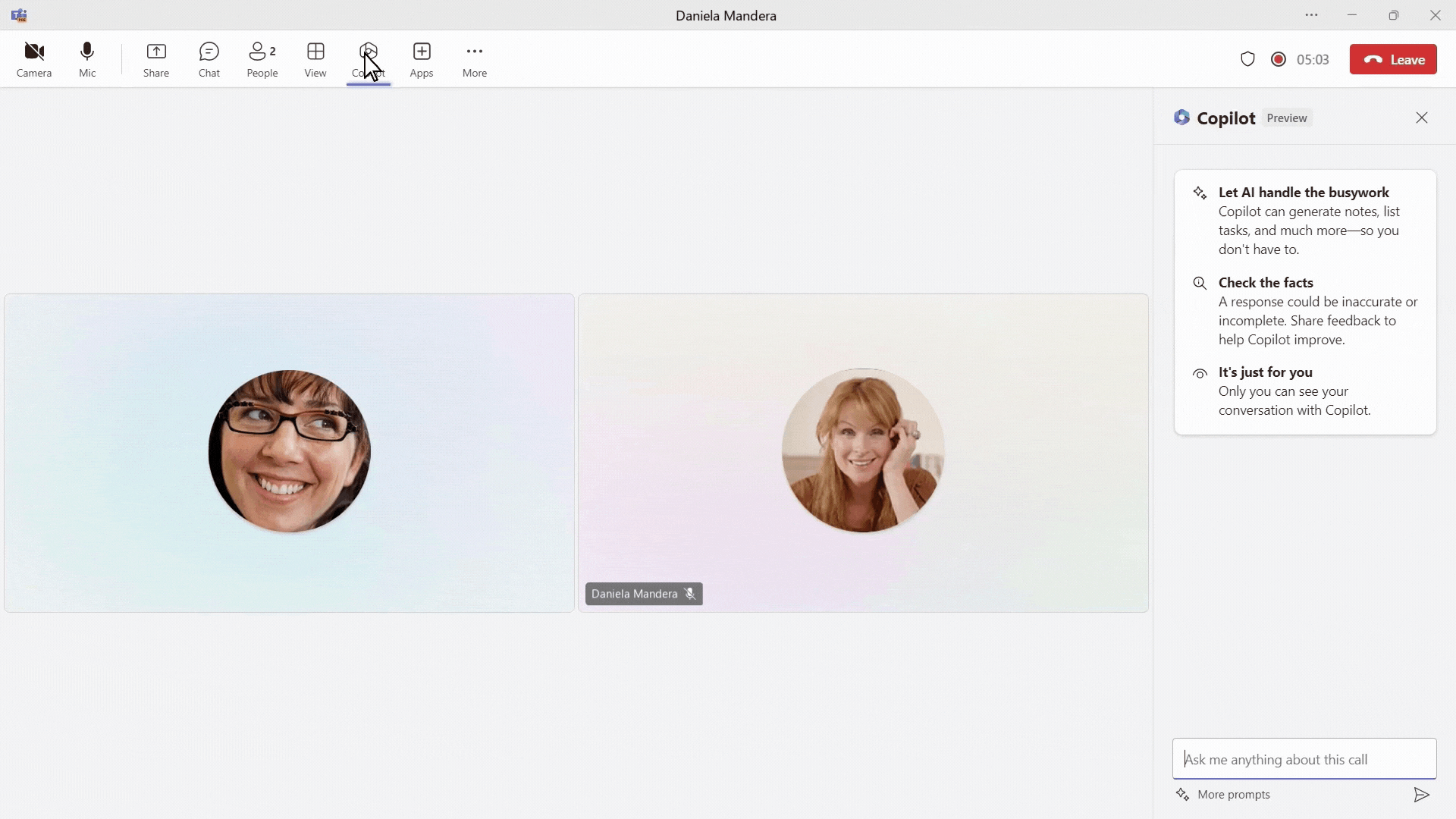
Copilot also excels in task management within Teams. It allows you to create and assign tasks directly from your chats and meetings. This ensures that follow-up actions are clearly defined and tracked. To stay organized, make it a habit to use Copilot’s task management features regularly. This not only helps in keeping track of ongoing projects but also ensures that responsibilities are clearly assigned and deadlines are met. For more insights on task management and project tracking, check out this article on Microsoft Planner Templates in Teams.
Customizing Copilot for Better Results
Customizing prompts in Copilot can further enhance its usefulness. By tailoring the prompts to your specific needs, you can get more relevant and actionable insights during your meetings. This customization allows you to focus on what’s most important and make informed decisions quickly. For tips on using Teams for client communication and management, refer to this guide on Using Microsoft Teams for Client Communication and Management.
For more detailed instructions on getting started with Copilot in Microsoft Teams, you can visit the Microsoft Support page. To learn how to use Copilot in Teams chats and channels, check out this guide. Additionally, for a comprehensive overview of setting up Copilot for Microsoft 365 in Teams, refer to this resource.
4. Using Microsoft Copilot in Outlook
Microsoft Copilot in Outlook is a valuable tool designed to make your email and calendar management smoother and more efficient. Copilot helps you draft emails quickly by suggesting content, correcting grammar, and improving clarity and tone. Whether you are responding to a client or drafting a report, Copilot ensures your messages are clear and well-structured, saving you time and effort. For more details on how Copilot enhances email drafting, check out this guide.
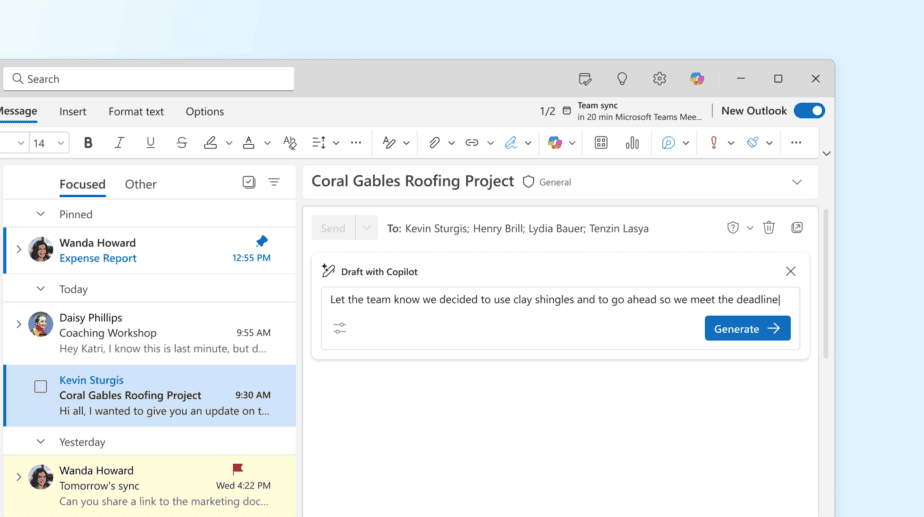
Besides email drafting, Copilot is great for managing your calendar. It helps schedule meetings, set reminders, and keep your calendar up-to-date. By understanding your schedule and preferences, Copilot suggests the best meeting times to avoid conflicts. You can learn more about these features in this article.
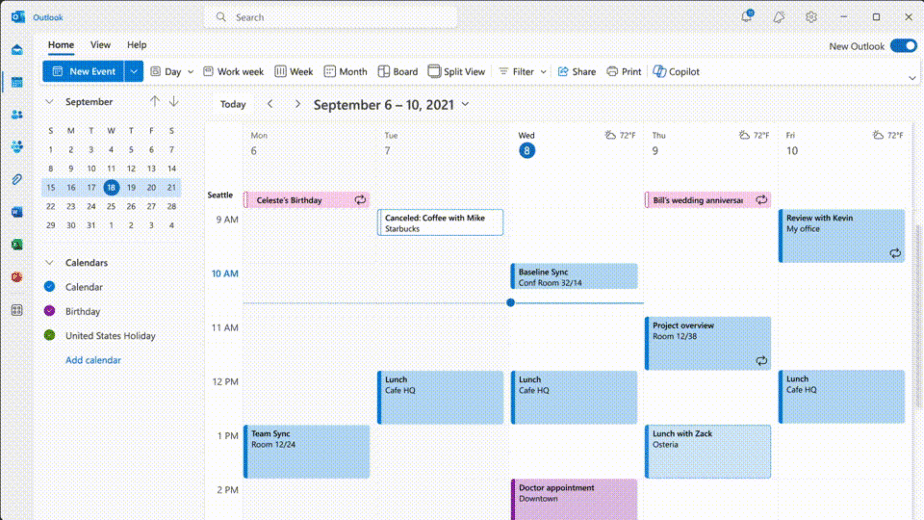
One of the best features of Copilot is its ability to automate routine tasks. It can create follow-up tasks directly from your emails, set reminders, and manage task creation, ensuring you stay on top of your responsibilities and deadlines. If you are interested in reading more about task automation, see this resource.
As a result, if you wish to boost your productivity, regularly use these features and fully use Copilot’s capabilities in Outlook. Use its email drafting features frequently to write better emails and save time. Let Copilot handle your calendar by efficiently setting up meetings and reminders. Use task automation to keep your workflow organized and ensure you don’t miss any important follow-ups. Those will simplify complex processes and help you stay on top of your email and calendar management. This will make your workday more efficient and improve the quality of your communication and task management.
5. Leveraging Microsoft Copilot in Word
Microsoft Copilot in Word is a game-changer for boosting productivity by assisting with drafting, editing, formatting, and researching. It’s designed to make your writing tasks easier and more efficient. Copilot helps you draft and edit text by suggesting content, correcting your grammar, and improving clarity and style. Whether you are working on a report or an article, Copilot ensures your writing is polished and professional. If you wish to learn more about these features, check out this guide.
One of the key benefits of Copilot is its ability to assist with document formatting. It helps apply consistent styles, adjust layouts, and maintain a professional look throughout your document. This is particularly useful for ensuring that your documents are not only well-written but also visually appealing. Check out this article to learn more about these formatting tools.
Research and referencing are also made easier with Copilot. It can help you find relevant information, generate citations but also add references seamlessly. This will save you a lot of time and effort. For a deeper dive into these features, see this resource.
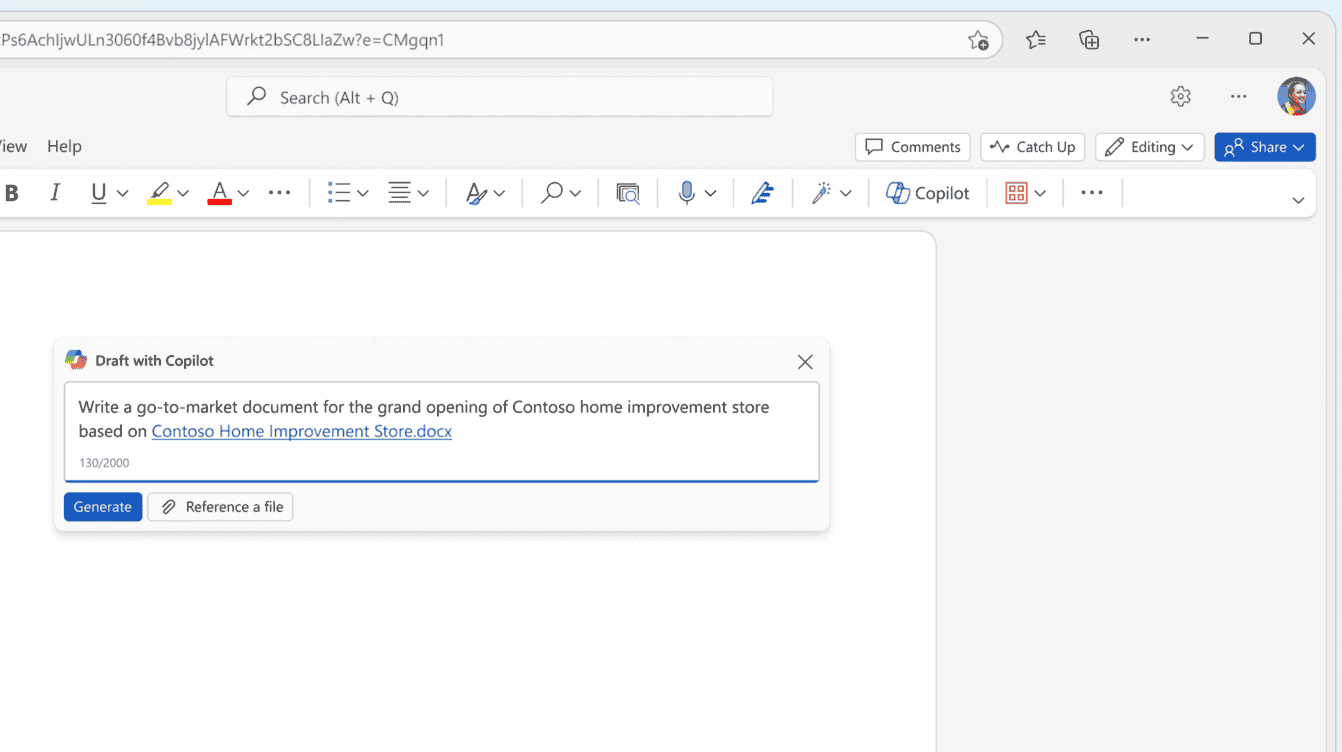
By incorporating these features into your workflow, you can significantly increase your productivity. If you integrate it in your daily routine, it can simplify your writing process and ensure that your documents are top-notch. This will not only make your workday more efficient but also elevate the standard of your written communications. For more tips and comprehensive guides on using Copilot in Word, visit Microsoft’s official Copilot resources where you have access to a variety of articles.
6. Additional Applications of Microsoft Copilot
Microsoft Copilot isn’t just limited to Word and Outlook. It is integrated into a range of Microsoft Office applications, including Excel, PowerPoint, OneNote, and Forms. Each of these applications leverages Copilot’s advanced AI capabilities to help users perform tasks more efficiently and effectively.
| App | How it Enhances Functionality | Use Case | Scenario |
|---|---|---|---|
| Excel | Suggests formulas, generates charts, automates data entry | Financial Reporting | Generate detailed financial reports with data visualizations |
| Project Management | Create and update project schedules and budgets efficiently | ||
| PowerPoint | Creates slides, suggests layouts, improves design | Sales Presentations | Draft compelling sales presentations quickly |
| Training Materials | Develop engaging training modules | ||
| OneNote | Organizes notes, facilitates real-time collaboration | Meeting Notes | Capture and organize meeting notes effortlessly |
| Research Projects | Collect and organize research data efficiently | ||
| Forms | Generates questions, structures surveys | Customer Feedback | Design comprehensive feedback surveys |
| Event Registrations | Create and manage registration forms effortlessly | ||
| Loop | Facilitates real-time collaborative content creation | Team Collaboration | Create and edit shared documents and projects in real-time |
| Project Brainstorming | Generate and organize ideas collaboratively |
7. Integrating Third-Party Applications with Copilot
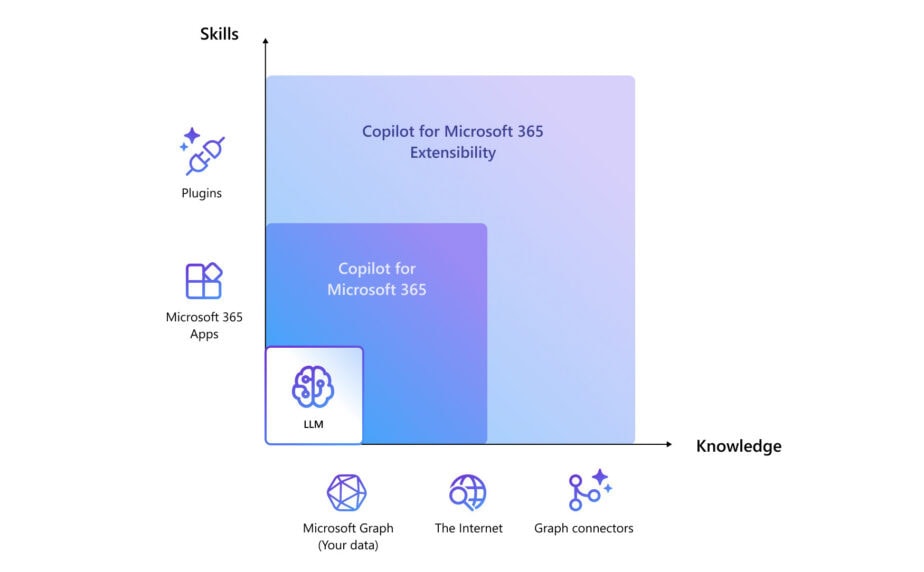
Microsoft Copilot plugins extend its capabilities by integrating third-party applications. This integration provides access to more tools and data sources, streamlines workflows, and boosts productivity by allowing tasks across multiple platforms without switching applications. Check the Microsoft 365 Copilot Extensibility Overview for more information on the extensibility of Copilot.
How to Set Up Integrations:
- Determine which third-party applications you need.
- Access the Microsoft 365 Admin Center and enable the required plugins in Copilot settings. For detailed instructions, visit the Overview of Copilot API Plugins.
- Ensure permissions are set for data access.
- Follow the instructions to install and set up the plugins. For step-by-step guidance, refer to Getting to Know Copilot Plugins.
Popular third-party applications integrated with Copilot include Trello, which helps manage tasks and projects within Teams. There is also Salesforce, which allows access to CRM data in Outlook and Teams. Asana integrates task management with Word and Teams, while Slack syncs communications and notifications with Teams. Finally, GitHub enables collaboration on code and projects within Teams and Word.
To manage integration, you should regularly update applications and plugins, monitor performance, train users, and maintain strict data security protocols.
8. Advanced Tips and Tricks
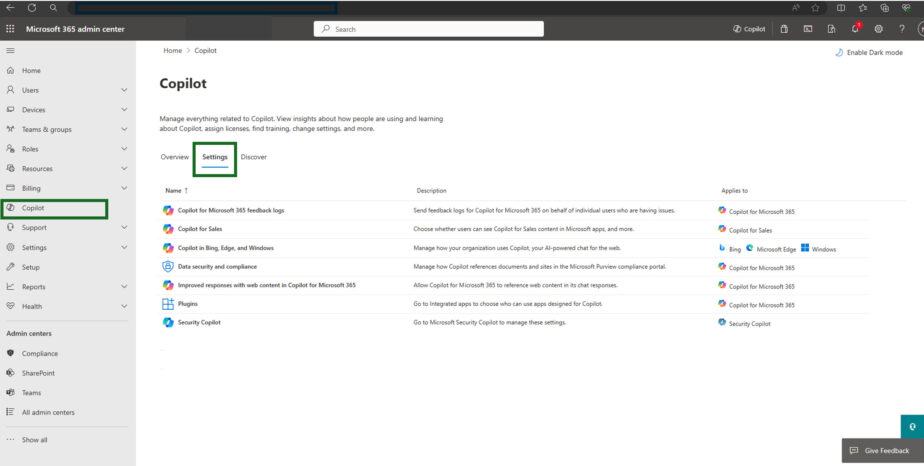
- To enhance your experience, adjust Copilot settings in your Microsoft 365 apps. You can customize the level of assistance and types of suggestions you receive according to your needs by modifying notification settings to get alerts relevant to your tasks, ensuring a tailored workflow.
- As explained above, Copilot can integrate with tools like Trello, Salesforce, and Asana. Access the integration settings in the Microsoft 365 admin center to connect these tools. This allows you to manage tasks, access CRM data, and collaborate on projects directly within Microsoft apps, streamlining your workflow.
- For common issues like integration problems or performance lags, ensure your Microsoft 365 apps and Copilot plugins are up-to-date. Check and reconfigure permissions if needed. For performance issues, close unused applications and clear your cache. Visit Microsoft’s FAQ section for solutions and tips on optimizing Copilot performance.
By customizing settings, integrating with other tools, and resolving issues efficiently, you can fully leverage the benefits of Microsoft Copilot and enhance your productivity.
9. Real-World Case Studies
Success Stories in Financial and Healthcare Sectors

Numerous businesses across different sectors have successfully integrated Microsoft Copilot into their workflows. For example, financial services organizations like PNB have used Copilot to automate data analysis and reporting. This significantly reduced the time spent on these tasks. In the healthcare sector, companies like HealthTech have utilized Copilot to streamline patient data management and enhance communication among medical staff.
It has therefore been proved that the implementation of Microsoft Copilot has led to notable improvements in productivity and efficiency. In the financial sector, businesses have reported a reduction in time spent on data analysis by up to 50%. This time-saving translates to more resources being allocated to strategic decision-making and client services. Similarly, in healthcare, the automation of routine tasks has allowed medical professionals to focus more on patient care, improving overall service quality.
Key Lessons and Best Practices
In the tech industry, companies have observed enhanced project management capabilities. For instance, integrating Copilot with tools like Asana, a project management tool designed to help teams organize, track, and manage their work, and Trello, a visual collaboration tool that organizes tasks into boards and cards, has streamlined task assignments and progress tracking. This integration leads to more cohesive team collaboration and timely project completions.
From these real-world implementations, several lessons and best practices have emerged. Firstly, it is crucial to ensure that all team members are adequately trained to use Copilot effectively. Proper training maximizes the benefits of the tool and minimizes resistance to change.
Another key takeaway is the importance of customizing Copilot settings to align with specific business needs. Tailoring the AI’s suggestions and automation capabilities ensures that Copilot provides the most relevant and useful assistance.
Overall, Microsoft Copilot has proven to be a valuable asset across various industries. By implementing best practices, organizations can fully capitalize on the capabilities of Copilot to drive efficiency and success in their operations.
If you wish to learn more, visit sources like Creospark, Redress Compliance, and Cloud Essentials.
10. Resources for Microsoft Copilot
To get the most out of Microsoft Copilot, it’s beneficial to utilize various resources for tips and updates. Microsoft’s official documentation covers everything from setup to advanced features. For all the details, you can visit the Microsoft Copilot for Microsoft 365 documentation. The Support Center also provides step-by-step guides, tips, and real-life use cases for using Copilot in apps like Word, Outlook, and Excel.
Staying updated on new features and enhancements is crucial. The Microsoft Teams Tech Community Blog is a valuable resource for expert advice and updates. Microsoft also releases monthly updates highlighting the latest features, which you can find on the Copilot for Microsoft 365 page.

For advanced tips, check out guides and tutorials from Most Valuable Professionals (MVPs). MVPs are experienced community leaders recognized by Microsoft for their contributions and expertise. They often share in-depth guides, tutorials, and best practices based on their extensive experience with Microsoft tools. You can explore their insights on the MVP Blog. You can also check this relevant article by Jason Wynn. Additionally, many MVPs are active on social media, such as Twitter, where they share valuable tips and engage with the community. For example, you can follow MVPs like @simondoy or even the Microsoft MVP Communities (@MVPAward) for insights and updates on using Microsoft Copilot effectively.
Then, if you are looking to deepen your knowledge, there are several books, online courses, and webinars available that cover Microsoft Copilot and related productivity tools. Platforms like LinkedIn Learning, Coursera, and Pluralsight offer courses on Microsoft 365 and Copilot. Microsoft also hosts webinars and virtual events, which you can find on the Microsoft Events page.
11. How to Pilot Microsoft Copilot
Piloting Microsoft Copilot involves testing the tool within your organization to ensure it meets your needs and integrates smoothly with your existing workflows. This process helps identify any potential issues and allows you to gather feedback from users before a full-scale rollout.
Here are the key steps to get started:
- Prepare Your Environment: Ensure compatibility and update necessary applications.
- Enable Copilot Features: Go to the Microsoft 365 admin center and enable Copilot for selected users.
- Configure Permissions: Set up permissions to allow Copilot access to required data.
- Deploy to a Test Group: Start with a small group of users to monitor performance and gather feedback.
- Monitor and Adjust: Use the dashboards in the Microsoft 365 admin portal and Microsoft Viva to continuously monitor the pilot and make adjustments based on feedback.
If you need more detailed setup instructions, you can visit the Microsoft Copilot Setup page.
To pilot Copilot effectively, start with a small, diverse group and expand gradually. This phased approach allows for manageable integration and easier troubleshooting. Provide proper training and resources to help users understand how to use Copilot efficiently. Additionally, ensure compliance with data protection laws to protect your organization’s data integrity. Regularly check the Microsoft Teams Tech Community Blog for tips and real-world examples to tailor Copilot to your needs and address common challenges.
For an in-depth guide on piloting Copilot, including best practices and insights, visit this detailed article on CoreView. This article provides a comprehensive overview of the pilot process, including how to prepare your environment, enable and configure Copilot features, and deploy to a test group. It also covers best practices for monitoring and adjusting the pilot, training users, and ensuring compliance with data protection laws. The guide offers practical insights on managing feedback, troubleshooting common issues, and leveraging community resources to maximize the effectiveness of your Copilot implementation.
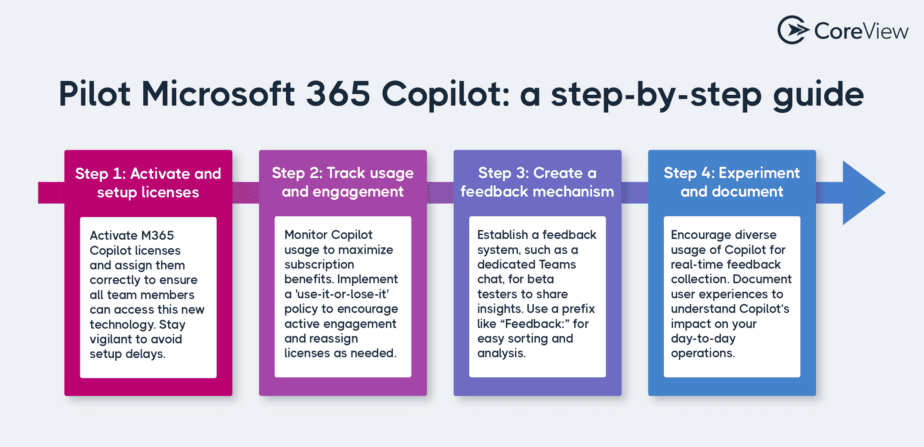
Conclusion
Microsoft Copilot is set to revolutionize productivity by streamlining tasks and enhancing workflows across various Microsoft applications. By leveraging advanced AI, Copilot simplifies routine tasks, provides insightful suggestions, and automates complex processes, making it an indispensable tool for both individuals and organizations. Whether you’re drafting emails in Outlook, managing projects in Teams, or creating documents in Word, Copilot can significantly boost your efficiency and productivity. Start using Copilot today to transform the way you work and achieve more with less effort.
Feel free to leave comments or questions, and don’t hesitate to check out our other articles on Microsoft tools and features for even more insights.
